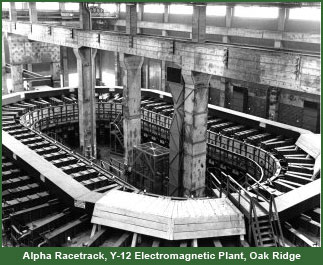
Time Periods
1890s-1939:
Atomic Discoveries
1939-1942:
Early
Government Support
1942-1944:
The Uranium
Path to
the Bomb
1942-1944:
The Plutonium
Path to
the Bomb
|
The uranium path to the atomic bomb ran through Oak Ridge, Tennessee. Only if the new plants built at Oak Ridge produced enough enriched uranium-235 would a uranium bomb be possible. General Groves placed two methods into production: 1) electromagnetic, based on the principle that charged particles of the lighter isotope would be deflected more when passing through a magnetic field; and 2) gaseous diffusion, based on the principle that molecules of the lighter isotope, uranium-235, would pass more readily through a porous barrier. Full-scale electromagnetic and gaseous diffusion production plants were built at Oak Ridge at sites designated as "Y-12" and "K-25", respectively.
Sources and notes for this page. The text for this page is original to the Department of Energy's Office of History and Heritage Resources. Portions were adapted or taken directly from the History Office publications: Terrence R. Fehner and F. G. Gosling, Origins of the Nevada Test Site (DOE/MA-0518; Washington: History Division, Department of Energy, December 2000), 26, and Richard G. Hewlett and Oscar E. Anderson, Jr., The New World, 1939-1946: Volume I, A History of the United States Atomic Energy Commission (Washington: U.S. Atomic Energy Commission, 1972), 167. Click here for more information on the picture of the Alpha racetrack at Y-12. The photograph of K-25 is courtesy the Federation of American Scientists. The aerial photograph showing S-50, the power plant for K-25, and the Clinch River, is reproduced in the History Office publication: Richard G. Hewlett and Oscar E. Anderson, Jr., The New World, 1939-1946, between pages 296 and 297.
Home |
History Office
|
OpenNet
|
DOE
|
Privacy and Security Notices |



